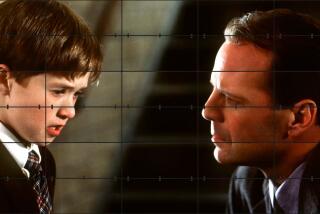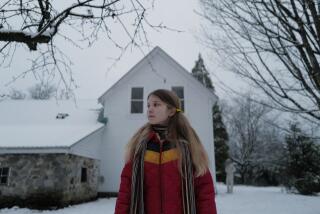How Nicolas Cage helped Richard Stanley return to directing with ‘Color Out of Space’

On the third day of filming “Color Out of Space,” his first narrative feature in over two decades, Richard Stanley finally let himself believe he was making another movie.
“My initial sense of incredulity wore off,” said the South African director. Best known for his cult 1990 cyberpunk debut, “Hardware,” Stanley returns to the director’s chair with the H.P. Lovecraft tale starring Nicolas Cage as a man whose family is transformed when a mysterious meteorite lands in its yard.
Three days were also about how long it took for him to be fired from the set of 1996’s “The Island of Dr. Moreau.” The famously disastrous Marlon Brando-Val Kilmer picture was once set to be his Hollywood studio breakthrough but instead brought his career to a grinding halt.
That experience left him, understandably, shaken. He wouldn’t direct another narrative feature for more than 20 years. So it was reassuring for him to discover that being back on set with “Color Out of Space,” which is now playing in limited release, brought his instincts back into focus.
“I realized it was genuine. I also realized I had some director software in my head that was telling me the shot lists and where to put the camera,” he said with a smile. “It wasn’t even just coming back. It was there.”
Stanley’s striking style and metaphysical interests find a well-suited avatar in Cage, unleashed in “Color Out of Space” to wax manic while milking alpacas and excavating layers of patriarchal toxicity in his character, a loving husband and father gone unhinged.
“When you first meet him,” Cage says of Stanley, “he can look like a bit of a sorcerer: You don’t know what you’re going to get, in a wonderful way, but he can have that intensity.” He’s “a genuine original.”
They met “a million years ago” to discuss Stanley’s second film, the 1992 horror movie “Dust Devil.” Cage remembered the director’s distinctive vision when he was wooed to Stanley’s long-gestating passion project by the genre producers at SpectreVision, to whom Cage had expressed his interest in the works of Lovecraft.
“I could see he had a powerful connection with his mom. I had a powerful connection with my father. So Richard and I had a lot to talk about together and felt the connection of a kindred spirit,” Cage said. “We could speak the same language.”
The absence of Stanley, now 53, from behind the camera was one of the longstanding curiosities of the genre film world. Tall, with a goatee and his trademark wide-brimmed hat worn over long dark hair, the director has relocated to a remote village called Montségur, in the French Pyrenees mountains, near a historic castle whose violent and mystical roots have held his fascination for years.
In the 13th century, more than 200 villagers burned to death there after being besieged by Inquisition crusaders. Seven hundred years later, Nazi archaeologists came looking for the Holy Grail. Occultists and historians still find the region fascinating, but for Stanley in particular it opened a window he never expected.
“It’s the only place in the world,” he said, “that’s budged me from my atheism and my skepticism and forced me to accept that there’s more going on in the world than I can easily explain.”
Several of Stanley’s personal interests converged in “Color Out of Space,” a passion project he’d been trying to get made for many years. Growing up in South Africa, he inherited a love for Lovecraft from his mother, who would read him the author’s stories. He gravitated toward Lovecraft’s original story “The Colour Out of Space,” written in 1927, in which a family is driven mad by the arrival of a strange meteorite that emits a color-like presence.
With co-writer Scarlett Amaris, he updated it with a modern setting, telling the story of Nathan Gardner (Cage), who moves with his wife, Theresa (Joely Richardson), their teenage daughter, Lavinia (Madeleine Arthur), teenage son Benny (Brendan Meyer) and young son Jack (Julian Hilliard) to a remote farm to get a fresh start raising tomatoes and alpacas.
Filmed in Portugal on an atmospheric farmhouse set that resembled his beloved Montségur, Stanley’s “Color Out of Space” unfolds as the “color” begins seeping across the land, altering everything organic that it touches. The fruit becomes inedible and the Gardners begin losing their minds. Lavinia, a budding occultist, turns to her paperback “Necronomicon” for answers. A visiting hydrologist (Elliot Knight), the film’s audience stand-in, attempts to make sense of what’s happening, to no avail.

The confluence of environmental disruption and psychological unraveling felt acutely topical to Stanley. “We’re all facing a situation where planet Earth and the future of mankind is starting to look more and more checkered. The world is clearly changing, and we’re not in control of that process,” he said. “We can no longer be certain that the world will be the same world for our children as it is for us. I think that’s a very distressing thought.”
But one relationship in “Color Out of Space” spoke even more personally to the filmmaker. As the sinister “color,” a rippling visual sentience achieved through VFX, makes Nathan increasingly irritable and unhinged, it also affects Theresa, who becomes distant and erratic. Their youngest, Jack, becomes the most vulnerable as the family drifts further into its spell.
“I was a lonely, creepy kid who spent most of my time doing crayon drawings of monsters,” Stanley said with a smile. In that childhood, he says, the fantastic was an escape and a way to deal with the discord in his parents’ relationship. Years later, “Color Out of Space” would serve a similar purpose.
One of the things he was doing during his two-decade absence from filmmaking, he said, was taking care of his dying mother as she battled cancer. Their complicated relationship, and his feelings about that period of his life, were some of the personal insights he shared with his actors before filming.
“Generally I find that it’s always good, just as when you’re acting, to be dealing from some moment of truth — from some personal truth — and to be as honest as possible,” he said. “It’s the first one of my movies that she won’t be watching. I think she would have rather enjoyed it.”
From a filmmaking standpoint, he adds, working on “Color Out of Space” and, specifically, with Cage and his free-flowing creative energy was a healing creative experience. “Nic single-handedly restored my faith in the entire process and in Hollywood,” Stanley said.
On set, he encouraged the actor to push the material further than what was on the page as the story’s tone morphed into a mélange of horror, comedy and pathos. “He has such a creative and really controlled use of insanity, as opposed to the kind of scattershot madness that brought down ‘Moreau,’” Stanley said. “It restored my faith in the process because that’s exactly what we needed.”
For every three or so of those full-throttle Cage “chaos” moments that made it into the final cut, there were three more left on the cutting-room floor. Cage likened his acting approach to jazz.
“One of my interests has been how to be in control while being out of control, or out of control while being in control. That, to me, is music,” he said. “With acting, in which my only instruments are my voice and my body and my facial expressions and my memory and my imagination, I know there are times where even though I am very well-rehearsed and I have a blueprint of everything that’s in the libretto, now we’re going to go into total chaos.”
He lamented a current moviemaking landscape in which idiosyncratic visions like Stanley’s are often subject to death by a thousand cuts from outside forces.
“There are kinds of conservative energies that really have no idea about filmmaking telling directors, or even actors, what they can and can’t do. They shut down and they take the oxygen out of the process of filmmaking,” he said. “I’m sure there’s a lot of stuff in this movie that I would like to see get the light of day on the Blu-ray with a director’s cut.”
As he looks to his next moves, Stanley hopes “Color Out of Space” reopens a door for new career opportunities. There are a mountain of “strange and terrifying” projects he’s long wanted to make, including a follow-up to “Hardware.” “Color Out of Space,” which premiered at the Toronto International Film Festival last September, has drawn positive critical reviews and an 84% Rotten Tomatoes score. “I think I used up all my bad luck vouchers on ‘Moreau,’” he said.
But, for now, he wants to spend more time with his cat. “I have a very large, fierce black cat. She is a big beast. Her name is Doozy, and she found me; she was a stray that adopted me.” While he’s been on tour promoting “Color Out of Space,” Doozy’s been looked after back home in France by a local witch, he said.
“There are a lot of witches in the area. I’m witch-friendly,” he explained with a smile. “I tend not to judge people.”
More to Read
Only good movies
Get the Indie Focus newsletter, Mark Olsen's weekly guide to the world of cinema.
You may occasionally receive promotional content from the Los Angeles Times.











